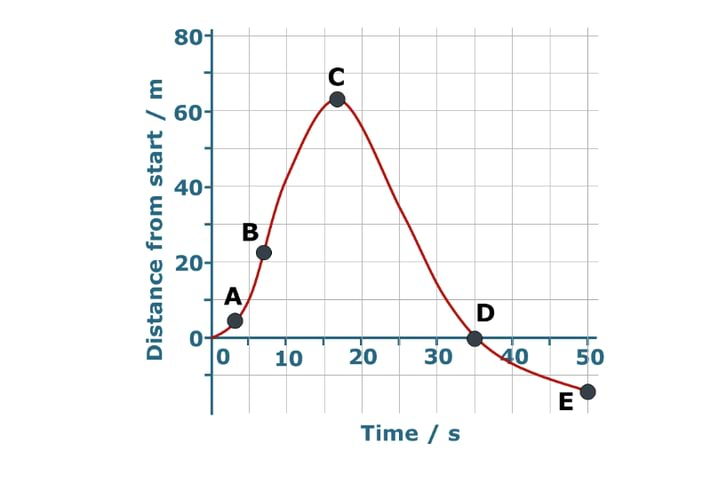Learning focus: | Information about the motion of an object can be summarised on a distance-time graph: the plot shows the object’s distance from the start at a given time and the slope (gradient) at that point shows its speed. |
Observable learning outcome: | Explain how a distance-time graph shows the changing speed of an object |
Question type: | Simple multiple choice |
Key words: | Distance, time, graph |
It is common for students to view motion graphs as pictures that link to existing physical knowledge of a situation. (Lingefjard and Farahani, 2018; Stump, 1999; Brasell, 1987; Clement, 1986) For example Clement (1986) found that 28% of 12- to 14-year-olds (n=25) drew an up-hills and down-hills picture of a cycle route when asked to draw a speed-distance graph. Likewise Lingefjard and Farahani (2018) found that 35% of 18-year-olds (n=17) interpreted distance-time graphs intuitively as if they were pictures.
Often text books (and teachers) put great attention on the procedures for plotting graphs and calculating gradients, rather than developing understanding of relationships that a graph shows (Stump, 1999). It can be more constructive to concentrate on the latter, which involves teaching:
- understanding of how to read information directly from a graph, interpreting each axis individually
- how to describe simple relationships between the axes such as those represented by straight lines
- how to interpret a graph, linking what it represents to a real situation (Friel, Curcio and Bright, 2001; Lingefjard and Farahani, 2018)
When interpreting graphs students must be able to determine which features of a graph correspond to particular physical concepts. With distance-time graphs there is often confusion between the slope (speed) and height (distance) of a graph (Clement, 1986; McDermott, Rosenquist and van Zee, 1987).
This question investigates students’ understanding of how distance-time graphs represent the changing position of an object in a real situation.
Students should complete the confidence grid individually. This could be a pencil and paper exercise, or you could use an electronic ‘voting system’ or mini white boards and the PowerPoint presentation. If there is a range of answers, you may choose to respond through structured class discussion. Ask one student to explain why they gave the answer they did; ask another student to explain why they agree with them; ask another to explain why they disagree, and so on. This sort of discussion gives students the opportunity to explore their thinking and for you to really understand their learning needs.
Differentiation
You may choose to read the questions to the class, so that everyone can focus on the science. In some situations it may be more appropriate for a teaching assistant to read for one or two students.
Most wrong answers will be caused by students interpreting the height of the graph as speed.
Dwight starts from rest and at A he is increasing his speed. This can be seen as the slope is becoming steeper and steeper. He is going fastest at B because this is the part of the line that is the steepest, so his distance from the start is changing faster than at any other point on the line.
Towards C the slope levels off and at C is level. This means that Dwight’s speed is zero. Just after C his distance from the start starts to decrease, which shows that at C he must have turned round.
At D Dwight has returned to his starting point and continues on to E, a little behind the starting line as he slows down (the slope becoming less steep).
The slope after C is less steep than the slope at B, which shows the speed at B was higher than between C and D.
If students have misunderstandings about how the graph represents the motion and speed of Dwight, it can help to discuss what the line on the graph represents along its length with overt reference to the labels on the axes.
Another strategy is to use motion sensors and data-loggers to plot real-time graphs of motion. Students can practise predicting the shape of graph for different descriptions of motion and also reproduce the shape of given graphs by moving in front of a motion sensor. The following BEST ‘response activity’ could be used to do this in follow-up to this diagnostic question:
Response activity: Speedy graphs
The effect of real-time laboratory graphing on learning graphic representations of distance and velocity
Brasell, H. (1987). The effect of real-time laboratory graphing on learning graphic representations of distance and velocity. Journal of Research in Science Teaching, 24(4), 385-395.Making Sense of Graphs: Critical Factors Influencing Comprehension and Instructional Implications
Friel, S. N., Curcio, F. R. and Bright, G. W. (2001). Making Sense of Graphs: Critical Factors Influencing Comprehension and Instructional Implications. Journal for Research in Mathematics Education, 32(2), 124-158.
